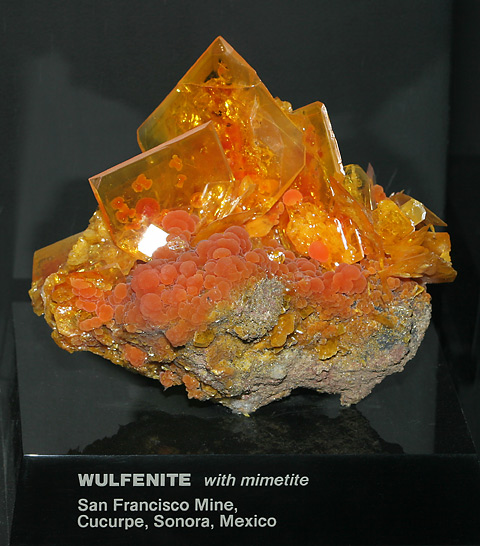
| Crystal system | Tetragonal |
| Transparency | Transparent to Translucent |
| Luster | Resinous to adamantine |
| Fracture | subconchoidal to uneven |
| Cleavage | Distinct |
| Specific Gravity | 6.5 to 7 |
| Hardness | 3 |
| Optical Character | Uniaxial- Double Refractive |
| Refractive index | 2.28 - 2.40 |
| Birefringence | 0.012 |
| Dispersion | |
| Fluorescence | |
| Pleochroism | Weak dichroic |
| Chemical Formula | PbMoO4 |
| Comments | Soluble in sulphuric acid, decomposed by nitric acid. |
| Streak | |
Wulfenite (WOLF-en-ite) is a lead molybdate, in which calcium may substitute for lead and tungsten for molybdenum; its formula is PbMoO4. It was named for Franz Wulfen (1728 - 1805), an Austrian mineralogist.
Wulfenite ranges in color from orangish-red to orange to yellow and is sometimes color zoned, with a dark "filling" layer between layers of lighter color. Although this mineral is soft and brittle, crystals have been cut into brilliant faceted gemstones.
This is a secondary mineral in oxidized zones of ore deposits containing lead and molybdenum. Sources include Chihauhua, Durango and Sonora, Mexico; Yugoslavia; Czechoslovakia; Austria; Poland; Bohemia; Morocco; the Republic of Zaire; and Australia. Outstanding bright orange-red crystals are found in Yuma County, Arizona; another source in the U. S. is Sierra County, New Mexico.
Wulfenite is brittle and fragile as well as somewhat sensitive to heat. Although cleavages are not troublesome, it must be handled carefully and facets should be inspected often to avoid pitting. Wulfenite should be pre-polished on a smooth tin lap with Linde A and the final polishing done with tin oxide on a wax lap. Recommended crown angles are 33° and pavilion angles, 40°.

